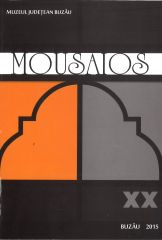Câteva date noi privind cronologia culturii Monteoru
Some new data regarding the chronology of the Monteoru culture
Author(s): Ion Motzoi - Chicideanu, Monica Chicideanu-ȘandorSubject(s): Archaeology
Published by: Muzeul Judetean Buzău
Keywords: Bronze Age; chronology; 14C; Monteoru culture; Romania;
Summary/Abstract: Already since the first half of the 20th Century the Monteoru Culture benefited of the interest of specialists. The cultural evolution was sketched, in principle, on the basis of research at the eponimous site, Sărata Monteoru. In the course of the long-lasting excavations there a stratigraphic sequence was established, but the published excavation reports were preliminary summaries, without any details concerning archaeological contexts and, moreover, their precise contents. For the Bronze Age sediments of the eponymous site 13 settlement layers were identified, which received provisional numbering during the excavation (notation was done from the lowest to the top layers as follows: Ic4-1, Ic4-2, Ic4-3, Ic3 with three layers, Ic2 with two layers, Ic1, Ib, Ia, IIa, IIb). At the same time it was observed that the Bronze Age layers directly overlay others attributed to a late phase of Cucuteni B. In a presentation, roughly 50 years ago, I. Nestor mentioned the possibility that during the formation of the Monteoru phenomenon „Cucuteni B elements (varianta Monteoru)” may have been integrated, an opinion which has been ignored with perseverance. The origin and the end of the Monteoru Culture are still controversial in spite of the fact that besides the excavations in the settlements and the funerary area - cemeteries 1-4, including the complex at the site Poiana Scoruşului -, studies have been carried out in other Monteoru ensembles/sites such as Bogdăneşti-Todoscanu, Cândeşti, Cârlomăneşti, Fitioneşti, Năeni-Zănoaga, Poiana and Pufeşti, to mention only a few. The efforts to place the Monteoru culture of the Bronze Age North of the Danube in a wider context of relative chronology used in Europe are well known. Romanian researchers have most frequently taken into account the Mycenaean civilization, their main argument being the presence of fayence beads and the boars tusks in funerary contexts, the spiral-meandroid decoration on vessels, harness components or metal objects, disc-shaped psalia (Scheibenknebel) and even groups of burials in stone rings at Cândeşti, thought to be inspired by the shaft-graves of circle A at Mycenae. A short time ago two radiocarbon dates have been published for the lower levels of Sărata Monteoru: the first sample from the Ic2 layer is Bln-4619 - 3919±48 BP, which gives a calibrated date of 2500-2220 BC (87.4%), while the second sample from the Ic3 layer is Bln-3065 - 3690±60 BP, which gives a calibrated date of 2210-1880 BC. The two datings appear o be contradictory, but they do exist and need to be taken into account. However, this is obviously not enough to place the early stages of the Monteoru culture in the absolute time-frame of the south-east European Bronze Age. We also have other elements (costume accessoires from burials), which allow permit relationships of the stages/phases of the Monteoru culture to neighbouring cultural areas, ad even to such that are further away, for which in their turn, radiocarbon dates exist. However, this is also not completely satisfactory for a good correlation with absolute chronology, not only of the Monteoru culture.
Journal: Mousaios
- Issue Year: 2015
- Issue No: 20
- Page Range: 9-52
- Page Count: 44
- Language: Romanian

